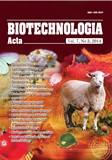ISSN 2410-7751 (Print)
ISSN 2410-776X (Online)

"Biotechnologia Acta" v. 7, no 3, 2014
https://doi.org/10.15407/biotech7.03.109
Р. 109-114, Bibliography 22, Russian.
Universal Decimal classification: 58.009
PRODUCTIVITY OF MICROALGAE SYSTEM CULTIVATION UNDER THE DAYLIGHT
B. Zarei Darki 1, О. N. Кorol 2, R. G. Gevorgiz 2
1 Faculty of Natural Resources and Marine Sciences, Marine Biology Group Tarbiat Modares University, Tehran, Iran
2 Institute of Biology of the Southern Seas of the National Academy of Sciences of Ukraine, Sevastopol, Ukraine
Extreme daily productivity values of microalgae culturing system with different orientation of the illuminated surface and under natural light were assessed. Calculations are made for natural light conditions around neighborhoods of Isfahan City (Iran). It is shown that if the efficiency factor of photosynthesis equals to 5%, limit values of productivity will be 38 grams of dry biomass per 1 m2 of illuminated surface and 114 grams will be at efficiency of 15%. On basis of simple model understandings regarding the daily distribution of solar radiation, which arrives at the surface of the Earth, productivity of microalgae culturing system for its various orientations relative to the Sun at different photosynthetic efficiency was calculated during the summer half-year (from March 21 to September 21). It is shown that the limit (optimal) value of the yield at the efficiency of 15% will be about 18.5 kg of dry biomass per square meter of illuminated surface.
The results can be used to develop technologies for the production of industrially important compounds from microalgae.
Key words: microalgae, limit assessment of productivity of microalgae system, photobiosynthesis, total solar radiation.
© Palladin Institute of Biochemistry of the National Academy of Sciences of Ukraine, 2014
References
1. Borowitska M. A. Commercial production of microalgae: ponds, tanks, tubes, and fermenters. J. Biotechnology. 1999, N70, P. 313–321.
2. PerezGarcia, O., Escalante, F. M. E.; deBashan, L.; Bashan, Y. Heterotrophic cultures of microalgae: Metabolism and potential products. Water Research. 2011, N45, P. 11–36.
3. Spolaore P., JoannisCossan C., Duran E., Isambert A. Commercial applications of microalgae (Review). J. Biosci Bioeng. 2006, 101(2), 87–96.
https://doi.org/0.1263/jbb.101.87
4. Choi H.J., Lee J.M., Lee S.M. A novel optical panel photobioreactor for cultivation of microalgae. Water Science & Technology. 2013, 67(11), 2543–2548.
https://doi.org/10.2166/wst.2013.128
5. Kumar K., Nag Dasgupta C., Nayak B., Lindblad P., Das D. Development of suitable photobioreactors for CO2 sequestration addressing global warming using green algae and cyanobacteria. Bioresource Technology. 2011, N102, P. 4945–4953.
https://doi.org/10.1016/j.biortech.2011.01.054
6. Loubi?re K., Olivo E., Bougaran G., Pruvost J., Robert R., Legrand J. A new photobioreactor for continuous microalgal production in hatcheries based on externalloop airlift and swirling flow. Biotechnology and Bioengineering. 2009, 102(1), 132–147.
https://doi.org/10.1002/bit.22035
7. Pulz O. Evaluation of Green Fuel’s 3D matrix algae growth engineering scale unit. Performance summary report, IGV Institut f?r Getreideverarbeitung GmbH, September 2007, 14 p.
8. Pulz O., Scheibenbogen K. Photobioreactors: design and performance with respect to energy input. Advances in biochemical engineering biotechnology. 1998, N59, P. 123–152.
https://doi.org/10.1007/bfb0102298
9. Ugwu C. U., Aoyagi H., Uchiyama H. Photobioreactors for mass cultivation of algae. Bioresource Technology. 2008, 99(10), P. 4021–4028.
https://doi.org/10.1016/j.biortech.2007.01.046
10. Blanken W., Cuaresma M., Wijffels R. H., Jansse M. Cultivation of microalgae on artificial light comes at a cost. Algal Research. 2013, 2(4), P. 333–340
https://doi.org/10.1016/j.algal.2013.09.004
11. ZareiDarki. B. Algae of water bodies of Iran. Abstract of the thesis for degree of philosophy doctor in biology, Kyiv. 2004, 20 p.
12. Belyanin V. N. Lightdependent growth of the lower phototrophs. Novosibirsk: Nauka Press, 1984, 96 p. (In Russian).
13. Vonshak A. Outdoor mass production of Spirulina: the basic concept. Spirulina platensis (Arthrospira): physiology, cellbilogy and biotechnology. UK: Taylor & Francis, 2002, P. 79–100.
14. Janssen M., Tramper J., Mur L. R., Wijffels R. H. Enclosed outdoor photobioreactors: light regime, photosynthetic efficiency, scaleup, and future prospects. Biotechnol Bioeng. 2003, N81, P. 193–210.
https://doi.org/10.1002/bit.10468
15. Lundquist T. J., Woertz I. C., Quinn N. W. T., Benemann J. R. A realistic Technological and Economic Assessment of Algae Biofuels. Report prepared for Energy Biosciences Institute, Barkley, California, October 2010, 153 p.
16. Belyanin V. N., Sidko F. Y., Trenkenshu A. P. Energy of photosynthesizing algae culture. Novosibirsk: Nauka Press, 1980, 136 p. (In Russian).
17. Tooming, H. G. and Gulyayev, B. I. Methods of measurement of photosynthetically active radiation. Moscow: Nauka Press, 1967, 144 p. (In Russian).
18. Gevorgiz R. G., Schepachev S. G., Korol O. N. Limiting estimate for microalgal productivity in natural and artificial lighting conditions. Ekologia morya. 2010, V. 80, P. 29–33. (In Russian).
19. Dynamic maps, GIS data and analysis tools, solar maps. National renewable energy laboratory (NREL), 2006. Available at http://www.nrel.gov/gis/solar.html.
20. Renewable energy unit. European commission, Joint research center institute for energy. 2013. Available at http://re.jrc.ec.europa.eu.
21. Khromov S. P., Petrosyants M. A. Meterology and climatology. Moscow University Press. 2001, 528 p. (In Russian).
22. Ministry of Road and Transportation. Isfahan Meteorological Bureau, 2010. — www.esfahanmet.ir.

